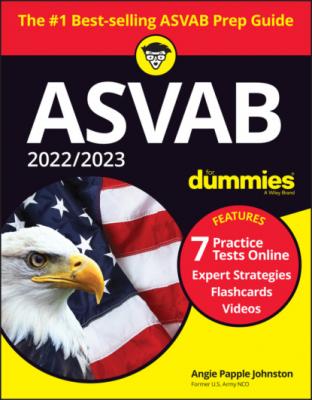2022 / 2023 ASVAB For Dummies. Angie Papple Johnston
Читать онлайн.| Название | 2022 / 2023 ASVAB For Dummies |
|---|---|
| Автор произведения | Angie Papple Johnston |
| Жанр | Учебная литература |
| Серия | |
| Издательство | Учебная литература |
| Год выпуска | 0 |
| isbn | 9781119870197 |
* The Assembling Objects subtest isn’t part of the student version of the test.
Eyeing Easy, Medium, and Hard Questions
The questions on the ASVAB range in difficulty from easy to hard, with most falling somewhere in the middle. On the paper-and-pencil version of the test, questions are presented in random order. For instance, you may see a hard question right off the bat, followed by a pair of easy questions and then a medium question. On the CAT-ASVAB, which I cover in more detail in Chapter 3, the questions you have to answer depend on how well you’re performing on the test. If you answer an easy question correctly, the computer will most likely give you a question of medium difficulty next; if you answer that one right, the next question is probably going to be harder.
Deciphering ASVAB Scores
The Department of Defense is an official U.S. Government agency, so (of course) it provides plenty of detail regarding your scores. When you receive your ASVAB score results, you don’t see just one score; you see several. Figure 1-1 shows an example of an ASVAB score card used by high school guidance counselors (for people who take the student version — see “Knowing Which Version You’re Taking” for details).
© John Wiley & Sons, Inc.
FIGURE 1-1: A sample ASVAB score card used by high school guidance counselors.
Figure 1-2 depicts an example of an ASVAB score card used for military enlistment purposes.
So what do all these different scores actually mean? Check out the following sections to find out.
© John Wiley & Sons, Inc.
FIGURE 1-2: A sample ASVAB score card used for military enlistment purposes.
Defining all the scores
When you take a test in high school, you usually receive a score that’s pretty easy to understand — A, B, C, D, or F. (If you do really well, the teacher may even draw a smiley face on the top of the page.) If only your ASVAB scores were as easy to understand.
In the following list, you see how your ASVAB test scores result in several different kinds of scores:
Raw score: This score is the total number of points you receive on each subtest of the ASVAB. Although you don’t see your raw scores on the ASVAB score cards, they’re used to calculate the other scores. You can’t use the practice tests in this book (or any other ASVAB study guide) to calculate your probable ASVAB score. ASVAB scores are calculated by using raw scores, and raw scores aren’t determined by adding the number of right or wrong answers. On the actual ASVAB, harder questions are worth more points than easier questions are.
Standard scores: The various subtests of the ASVAB are reported on the score cards as standard scores. A standard score is calculated by converting your raw score based on a standard distribution of scores with a mean of 50 and a standard deviation of 10. Don’t confuse a standard score with the graded-on-a-curve score you may have seen on school tests — where the scores range from 1 to 100 with the majority of students scoring between 70 and 100. With standard scores, the majority score is between 30 and 70. That means that a standard score of 50 is an average score and that a score of 60 is an above-average score.
Percentile scores: These scores range from 1 to 99. They express how well you did in comparison with another group called the norm. On the student version’s score card, the norm is fellow students in your same grade (except for the AFQT score).On the enlistment and student score cards, the AFQT score is presented as a percentile with the score normed using the 1997 Profile of American Youth, a national probability sample of 18-to-23-year-olds who took the ASVAB in 1997. For example, if you receive a percentile score of 72, you can say you scored as well as or better than 72 out of 100 of the norm group who took the test. (And by the way, this statistic from 1997
